Your cart is currently empty!
If you like to travel, then you know where Egypt stands on most people’s list. It took me a while to get there because a.) it takes a lot of planning and b.) flights and tours aren’t cheap. Back when the world stopped, I had a trip to Ecuador planned with G-Adventures, it was March 2020…. it got cancelled. Yep, you guessed it, because of Covid-19. I won’t get into details here, but know that I work healthcare, there was no break for me. I needed that trip and my wanderlust went unchecked for longer than I would have liked. The plus side is that since G-Adventures cancelled on me, I received 110% credit. Sooooo.. my friend and I looked into places that we didn’t want to worry about finding our own transport and checking flight prices and Egypt became the obvious choice. We booked it and a few months later, the beginning of the Israeli conflict heated up. I was plagued with many people asking if I was still going to go. I spent time watching the news and travel advisories and I felt resolved in the fact that if G-adventures didn’t cancel then I wasn’t either. It was a solid choice. I felt very safe in Egypt. We did modify our plans a bit and decided to stick with G-adventures and our hotel in Cairo for the transportation. We ditched our thoughts of going to the Red Sea due to increased reports of sexual assaults (mostly by staff at popular tourist places). This turned out to be a good decision because the Red Sea did have some activity from the war but it would have happened after we had returned. Anyway, having a war nearby did seem to cause a lot of other tourists to remain at home which meant the common hot spots weren’t as busy. At the end of this post, I will post some common tips and tricks we learned along the way and more comments about safety in general. Here is the start of the adventure…..
Day 1: Arrival into Cairo
Arrive at 12:15 am. We pre-arranged airport transfer and were met shortly after we exited the plane by an escort that walked us through the steps of getting through immigration and customs. It was nice because she would tell us what we needed and we breezed through all the stages. She escorted us to our van and we headed to the hotel: Pharaohs House. The hotel itself was clean but basic. The room had a fridge, 3 beds, large bathroom and outside balcony. The bed was pretty uncomfortable but again it was a clean room and during our stay we saw housekeeping thoroughly cleaning the hallway which is a huge plus. Another perk, the hotel has a restaurant with 24/7 service, including to the room.
We checked in and made our way to our room. We were exhausted from 26 hours of travel so we went basically settled in and went to sleep.
Day 2: Full day in Cairo
We woke up around 9am to catch the free breakfast. It was located on the 10th floor with views of the city. The buffet style was basic but free. We headed down to the lobby because they mentioned having tours when we checked in. We have some tours pre-planned with G-Adventures so we wanted something that wasn’t part of our itinerary. The guy at the front desk was able to recommend something that fit the bill. One hour later, we met our English speaking guide in the lobby and headed out to The National Museum of Egyptian Civilization. It had artifacts from all the dynasties that ruled Egypt. They also had sarcophaguses and mummified rulers in a lower level viewing area which was under security. Many were in very good condition and others a bit more damaged. Each had a description of the royalty and their accomplishments. There was also a small rotating display that had textiles and jewelry at the time of our visit. Our tour guide is an Egyptologist and was able to give us details on many of the items which made the museum better IMO. We spent about 1.5-2hours within the museum. Note: photos were not allowed in the lower level. They allow photos in the main level and do not charge a fee like some sites warn. Afterward, we headed to an aroma shop to see the oils used in everyday life, medicine and burial rituals. They had several scents and a guy allowing you to sell as many as you’d like. Note: this was the first con: I fell for it and spent more than I needed on perfume. DO NOT buy from the places on any tour, they charge more and kick back the money to the guide (whom you are likely to tip anyway). All the bazaars also have perfumes for much cheaper. Don’t make my mistake. Next, we headed to lunch. We had a speciality which included tomato sauce, noodles, rice, beans, fried onion, garlic/lemon sauce and chili. It was delicious but carb heavy. We headed back to the hotel to rest a while.



We returned back to our hotel and rested a bit. Jet lag is no joke on this trip!!! We pre-booked a Nile river dinner cruise on the Nile Crystal Sapphire and included transportation to and from. The food was buffet style with entertainment which included singing, belly dancing, etc… the entertainment wasn’t for us, coming from Las Vegas, we’ve seen some pretty spectacular singing and dancing and it wasn’t up to par. They were having fun though and most of the other guests seemed to enjoy it. We decided to ditch the entertainment and headed upstairs to sit outside and watch the view. It was nice to see the river at night. Dinner was included but drinks were an additional fee ($1 for a small water -$35 for a bottle of sparkling wine). All and all it was a nice leisure way to spend the evening. Our driver was late which added a hiccup of having to call the hotel to get a ride back but we did make it back. Once there we got ready for the official first pre-booked tour for tomorrow.



Day 3:
We woke up leisurely and ate breakfast still feeling some effects of jet lag. We had a tour booked to begin at 10am. We met our tour guide for the next 8 days in the lobby and another member of the tour group. Both seemed nice and we all were eager to start the day and get the first sights underway. We headed off in a van to sight see. We headed to Mohamed Ali mosque: The Muhammad Ali Mosque, also known as the Alabaster Mosque, is a prominent and historic mosque located on the Citadel of Saladin in Cairo, Egypt. It is named after Muhammad Ali Pasha, the Ottoman governor of Egypt, who commissioned its construction in the early 19th century. The Muhammad Ali Mosque was completed in 1848, and its construction marked a departure from traditional Mamluk architecture in Egypt. The mosque stands as a symbol of the Ottoman influence during Muhammad Ali Pasha’s rule and is a significant historical and architectural landmark in Cairo. Visitors to the Citadel can explore the mosque and enjoy its impressive design and historical significance. More info can be found here https://en.m.wikipedia.org/wiki/Muhammad_Ali_Mosque. The mosque was open to the public and shoes must be removed to walk around. You are allowed to take pictures and walk around. Outside is a panoramic view of Cairo and the pyramids in Giza can be seen far in the distance.



At the same location we went to: Al-Gawhara Palace. Al-Gawhara Palace, also known as the Jewel Palace, is a historic palace located within the Citadel of Saladin in Cairo, Egypt. It was constructed during the reign of Muhammad Ali Pasha in the 19th century. The palace served as the primary residence for Muhammad Ali and his successors. Today, Al-Gawhara Palace is open to the public as part of the larger Citadel complex. Visitors can explore its rooms, halls, and courtyards, appreciating its architectural beauty and historical significance. The palace offers insights into the political and social life of Egypt during the 19th century under Muhammad Ali Pasha’s rule. If you’d like more information: https://www.egypttoursplus.com/al-gawhara-palace/ This building was not open to the public but was quite the site to see from the outside.
Finally, the Citadel Saladin was the last stop at this location. The Citadel of Saladin, also known as the Cairo Citadel, is a historic Islamic fortification located on a high bluff in Cairo, Egypt. Here’s a concise history: Foundation: The Citadel was commissioned by Saladin, the famous Muslim military leader, in the 12th century. Construction began in 1176 CE, and it served both military and residential purposes. Military Fortress: Originally built to protect Cairo from Crusader attacks, the Citadel has been an essential defensive structure throughout its history. Architectural Evolution: Over the centuries, various rulers, including Mamluk and Ottoman leaders, made additions and renovations to the Citadel. The complex features mosques, palaces, and military structures. Muhammad Ali Pasha: In the early 19th century, Muhammad Ali Pasha, the Ottoman governor of Egypt, further expanded and modified the Citadel. He built the Alabaster Mosque (Muhammad Ali Mosque) and Al-Gawhara Palace within the complex. Strategic Importance: The Citadel continued to play a strategic role in Egyptian history, witnessing various political changes and conflicts. Modern Use: Today, the Citadel of Saladin is a UNESCO World Heritage Site and a popular tourist destination. It houses several museums, including the Military Museum, showcasing Egypt’s military history. The Citadel stands as a symbol of Cairo’s historical and architectural significance, reflecting the military and political events that have shaped the region over the centuries. More info here: https://en.m.wikipedia.org/wiki/Cairo_Citadel
Our driver picked us up and took us to the Coptic area where settlers came in the 16th century. The area had a lot of street vendors stalls, souvenirs, etc… as you entered the area, the paths became narrow and only accessible by foot. The pathway leading to our first stop had both walls lined with shelves upon shelves of books that were for sale. Occasionally there were shops cut out from the walkway. The Persians built a fort and the remains are visible throughout the area. The Coptic area is the oldest area of Cairo and has 5 churches, the first mosque and the oldest synagogue. We first checked out the Hanging Church: The Hanging Church, officially known as the Church of St. Virgin Mary, is one of the oldest churches in Cairo, Egypt. Here’s a brief history: Early Origins: The Hanging Church dates back to the 3rd century, with its current structure believed to have been built in the 7th century during the Arab occupation of Egypt. Location: Situated in the Coptic Christian quarter of Old Cairo, the church is dedicated to the Virgin Mary. Its name, “Hanging Church,” is derived from its location above the gatehouse of the Babylon Fortress. Historical Significance: The church holds historical and religious importance for Egypt’s Coptic Christian community. It served as the residence of the Coptic Patriarch for centuries and was a significant center for religious ceremonies. Architectural Features: The Hanging Church features a unique architectural style, combining Coptic, Roman, and Byzantine elements. The interior contains ornate woodwork, marble columns, and numerous religious artifacts. The Hanging Church stands as a testament to the enduring presence of Christianity in Egypt, and its historical significance makes it a popular destination for both tourists and pilgrims interested in exploring Egypt’s rich cultural and religious heritage. More information here: https://en.m.wikipedia.org/wiki/Hanging_Church

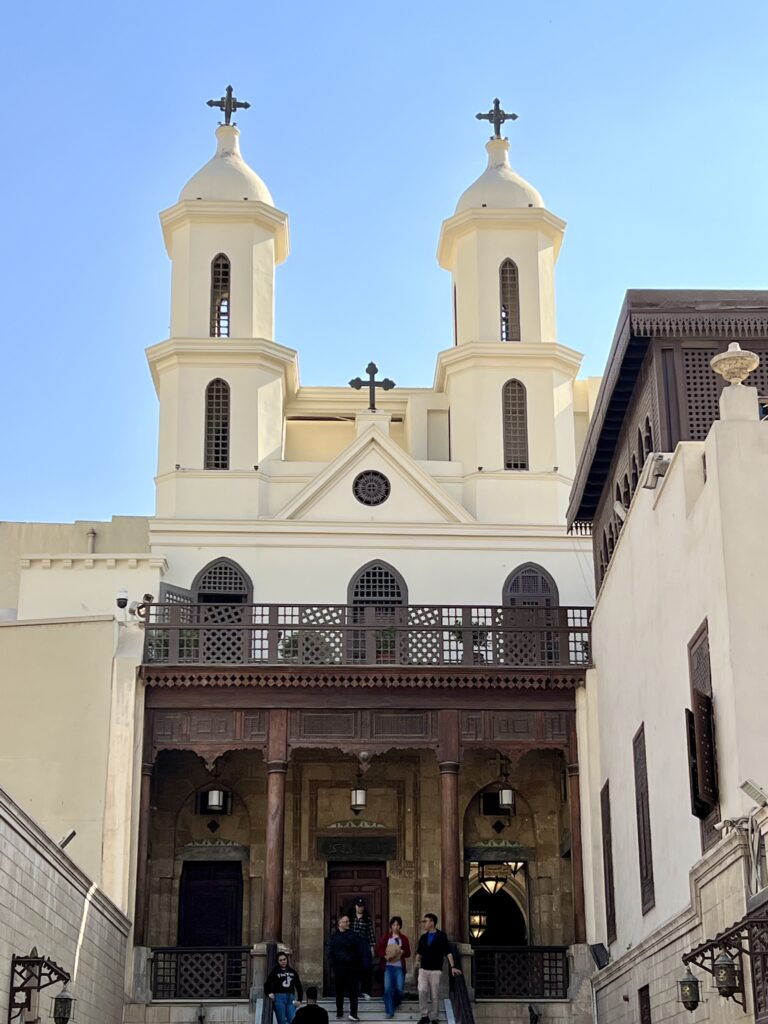


The path leading to the church had free bathrooms, new stained-glass murals and a decent amount of stairs to lead up to the church. You can enter the church, take photos, pray and spend as much or as little time as you want. The admission was free but it is an active church so you might check what time the services are as you can’t walk around as freely then. There are also plexiglass pieces covering the ground that shows the pillars that the church was built on, giving it the name Hanging Church.
The next stop was Saints Sergius and Bacchus Church. The Saints Sergius and Bacchus Church, also known as Abu Serga, is one of the oldest churches in Cairo, Egypt. Here’s a brief description: Early Origins: The church is believed to date back to the 4th century, possibly built over a crypt where the Holy Family, according to tradition, took refuge during their flight to Egypt. Location: Situated in the Coptic Christian quarter of Old Cairo, the church is dedicated to Saints Sergius and Bacchus, Christian martyrs from the 4th century. Architectural Style: The church exhibits a blend of Coptic and Byzantine architectural styles. It features a nave, aisles, and an apse, and the interior is adorned with intricate Coptic frescoes and carvings. Saints Sergius and Bacchus Church is not only a place of worship but also a historical site that offers insights into the early Christian history of Egypt. Its location in Old Cairo makes it a significant landmark for those interested in exploring the cultural and religious heritage of the region: https://en.m.wikipedia.org/wiki/Saints_Sergius_and_Bacchus_Church
This church allows photos and immediately entering has plexiglass on the floor that looks into a secret room. According to our guide, a body of a monk was found inside. There was also a small staircase behind the alter leading to a lower level ie crypt this is where it is believed to have a well blessed by Christ the child. It is covered by plexiglass and you can only view it from a balcony. This church doesn’t charge an admission and keeps regular hours but does occasionally close for ceremonies.
The last stop on this tour was: Synagogue Ben Ezra. The Ben Ezra Synagogue in Cairo, Egypt, is historically significant and has a rich history. Here’s a brief overview: Early History: The Ben Ezra Synagogue is believed to have been established in the 9th century, possibly around the 882 CE. It is situated in the historic Jewish quarter of Old Cairo, known as Fustat. Original Name: The synagogue was originally known as El-Shamieen Church but gained the name Ben Ezra after it was purchased by Abraham Ben Ezra, a wealthy merchant, in the 12th century. Genizah Discovery: In the late 19th century, the discovery of the Cairo Genizah in the synagogue’s attic attracted international attention. The genizah contained a vast collection of Jewish manuscripts and documents spanning many centuries. Cultural Heritage: The Ben Ezra Synagogue is not only a place of worship but also an important cultural and historical site that reflects the diverse history of the Jewish community in Egypt. Today, the Ben Ezra Synagogue stands as a testament to the multicultural history of Cairo, preserving the heritage of the Jewish community in Egypt. Visitors can explore its architectural features, historical artifacts, and the legacy of the Cairo Genizah. More information https://en.m.wikipedia.org/wiki/Ben_Ezra_Synagogue. This stop doesn’t allow photos to be taken inside. It is more flashy than the other churches but smaller inside. Admission was free but it is encourage to donate into a box. It was recently renovated to keep the integrity of the building and prevent the roof from collapsing to continue to improve tourism as there is an only a very small population of Jewish Egyptians. It has regular hours and primary purpose is tourism and museum.
We headed back toward the hotel and stopped for shawarma that was recommended by our guide. We relaxed a bit, showered and prepared for the full tour to start tomorrow before meeting the rest of our group at 6pm. Our group consisted of: Laurence and Tiek Fee a married couple from the UK (originally from Hong Kong and Malaysia). Their daughter Allison and her boyfriend Allister both from the UK. Sean a retired journalist from Wisconsin. A high school history teacher from Australia named Helen. A married couple: David and Monica from Spain. We are a mismatch of people with different professions but seem to get along well. We decided to have drinks/dinner at the hotel restaurant and get to know one another. We had an early start the following day so went to bed early.
Day 4: Cairo and night train to Aswan.
The tour officially started with breakfast at 6:30am with a 7:15 departure. We headed to the Giza pyramids.
We saw the large pyramid first. There is an optional fee of 900 Egyptian pounds to enter the large pyramid. We opted against it as there is another opportunity at another site that is free which was recommended by another person on the tour. This pyramid is rumored to be really small, and very hot, some of our group paid to do it and confined the said rumors. We wandered around a bit taking pictures. We managed to get extorted by one of the camel guys which at least got us a few good photos. Camels, carriages and horses are all over this tourist stop and per our tour guide should cost 300egp ($10USD). They will hustle you for more however. Our experience was that we were taking photos and he approached, we immediately said no to the camels. He then insisted on taking some photos of the three of us. We said no, but he carried on with “for free.” Honestly, to get him to stop harassing use, we just decided to allow him to take photos and planned to tip a few egp. It escalated to standing by the camels and then he was insistent on use getting on them. Then suddenly they wanted money and preferred USD and only wanted $20’s. I got out of there with paying $20. They did start to get angry after a while. It was a pretty bad experience and I’d avoid talking to these guys at all costs. As we toured, you learn to not engage, never hand off your phone unless you want to tip and “no” is the best word. After that encounter, we ventured around the back and saw 3 smaller “queens pyramids”. Then continued around the side. Here you will find a very steep runged climb into a small pyramid which is free. The climb down is no joke with low head clearance, photos are not allowed and it’s basically an empty small chamber. Of note: some men are there and try to “guide” you down, expecting tip. It is not necessary to tip them. Afterward, we hopped on the bus and we headed to the panorama area which over looked the 3 pyramids. The optional camel ride happened here for the guests that pre-paid the tour guide. We spent 45 mins here and headed to the sphinx next. At this site, there was the mummification chamber, the sphinx and a lot of vendors. We spent another hour here and finally left. Note: you can walk the entire site but tour buses drive you from each location. There are also bathrooms at all the locations which cost a nominal fee. The second location has outdoor bathrooms which are not as clean and smell worse. I was warned, but needed to go and it wasn’t that bad but the 1st and last bathrooms were much nicer. There are vendors all over the site and they will chase you around. If you look, they will hone in on you so be prepared.
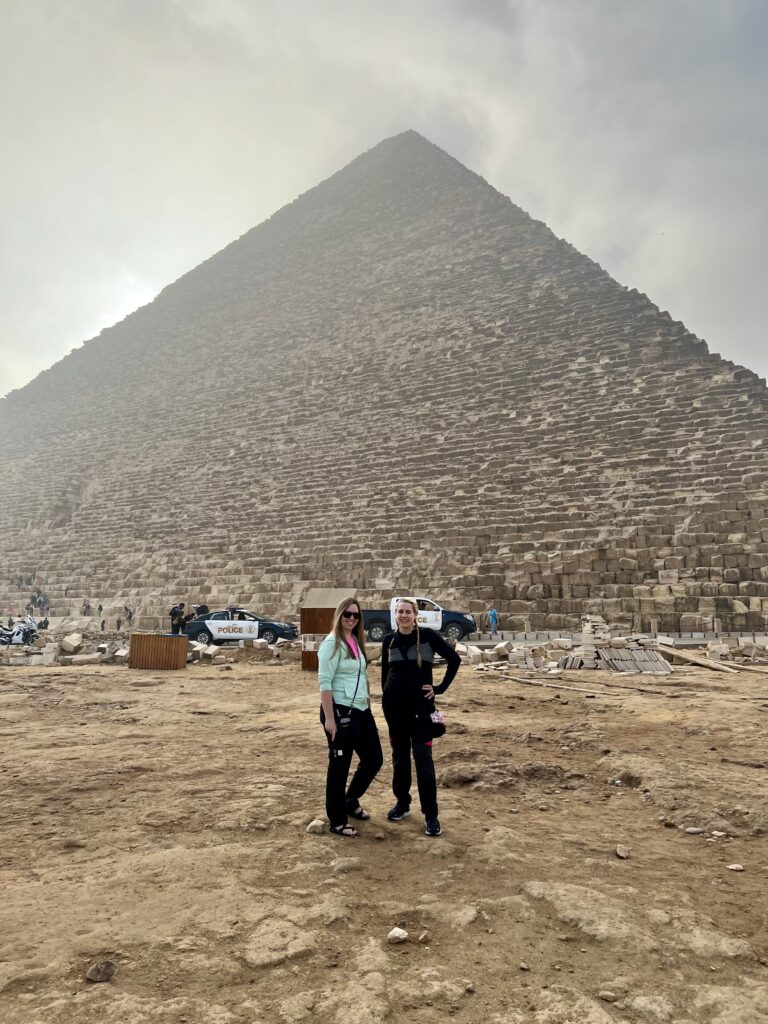




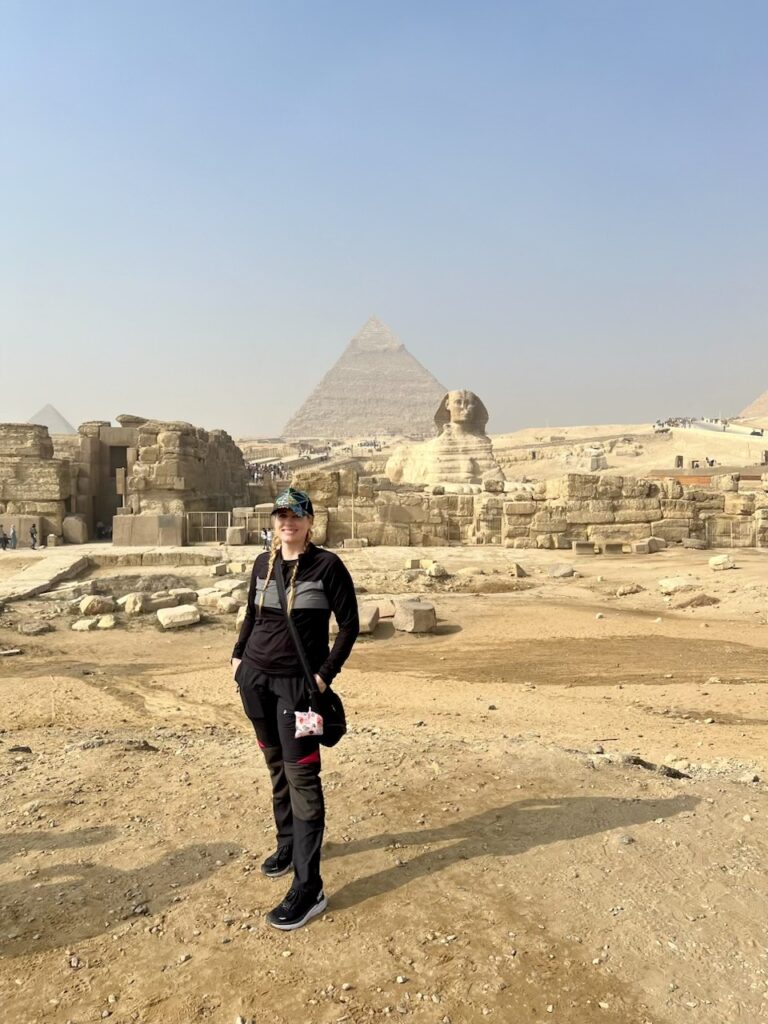


Next was lunch which consisted of pita, salad dips, grilled chicken skewer, rice, fries and rice pudding. It was so-so but I was hungry. We stopped at a papyrus shop, they explained how the papyrus paper is made and had multiple overpriced prices of art on papyrus displayed for purchase. But I was not about to be suckered twice as this is another stop where they kick back money to the tour guide. It’s not disclosed and that’s what makes me mad. However, as you travel throughout the country and talk to locals and other tourists, it’s fairly common knowledge. You will find papyrus all over Egypt: gift shops, bazaars, street vendors, etc. You can haggle it down to a pretty cheap price.
The last stop on the day was the Old Cairo Museum. They are transitioning to a new museum that has yet to open so many displays are missing as they have already been relocated. The museum was disappointing and generally unorganized. Lindsay, Helen and I ditched our main group and spent 2.5 hours touring the museum at our own pace. Honestly, this was a pretty big disappointment and it had more to do with timing of the displays being transitioned to the new museum. There was still some cool items but I think the new museum should be pretty awesome. We hit the gift shop where they had similar papyrus artwork for sale at fairer prices. I got some souvenirs and we met the group at a coffee shop to wait. We headed back to the hotel and were provided 3 rooms to shower and relax. Lindsay, Helen and I shared one and then headed down to the cafe to get dinner prior to heading to the train station.


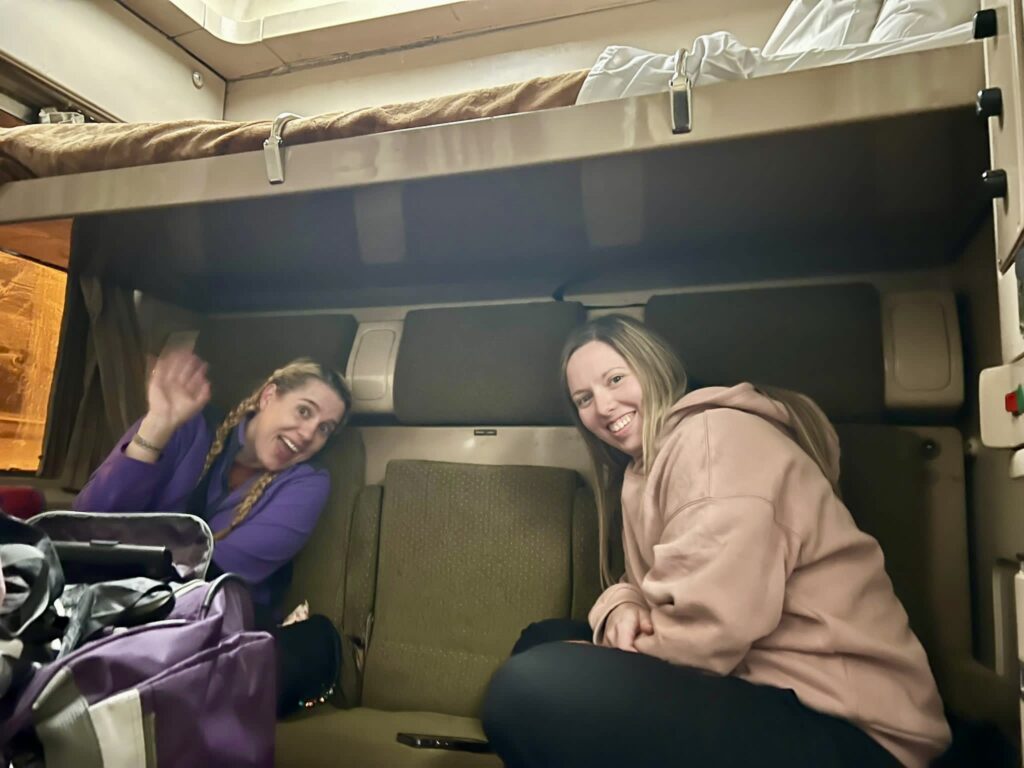
We arrived around 7pm and our group was a spectacle for the hour we waited for our 7:20 train which means little here. We boarded around 8pm and settled it for the 12-15 hour train ride without one “official” stop. It’s now 9:30 and we’ve already stopped once.
The train we have an only sleeping cars. My friend and I have a double bunk with an adjoining room to Helen. It’s clean but rough. The track is rough and overall it will be a potentially rough evening. The meal resembled airline food so definitely glad we had dinner prior to our departure. The train ride was noisy and super bumpy. Using the restroom was interesting. The bathrooms were kept clean but it’s just hard to use it while attempting to hover while sustaining pretty large bumps and constant vibration. I did discover plastic toilet seat covers which was a game changer being able to sit. I fell asleep rather easily and slept good until 5am.
Day 5. Arrival and full day in Aswan
We arrived in Aswan around 8:30am and headed to our bus. We loaded in, rode for 20minutes and hopped on a small motorized boat and headed to the island of Aglikia. There of course were vendors set up on the dock selling souvenirs. I did find a unique masks carved from wood. It was a piece I haven’t seen and now that I’m back, I still never saw them again. I talked the guy down to a price that I felt good with and wasn’t cutting him short either. On this island is the Temple of Philae: The Philae Temple is an ancient Egyptian temple complex dedicated to the goddess Isis. Here’s a brief overview: Location: Originally situated on the island of Philae in the Nile River near Aswan, the temple was later relocated to Agilkia Island due to the construction of the Aswan High Dam. Construction: The temple complex dates back to the Ptolemaic and Roman periods, with construction starting around 380 BCE and continuing through the reign of various rulers, including the Roman emperor Augustus. Dedication: Philae Temple is dedicated primarily to the goddess Isis, the wife of Osiris and mother of Horus, one of the most revered deities in the ancient Egyptian pantheon. Architectural Features: The temple boasts impressive structures, including the main temple dedicated to Isis, as well as other shrines and sanctuaries dedicated to gods like Hathor and Harendotes. The complex is adorned with intricate reliefs, hieroglyphs, and columns. Relocation: In the 1960s, the temple complex was dismantled and relocated to Agilkia Island to save it from being submerged by the rising waters of Lake Nasser caused by the Aswan High Dam. Isis Cult: The worship of Isis at Philae Temple continued for centuries, even into the Christian era, and the temple complex incorporates a blend of Egyptian and Greco-Roman architectural styles. UNESCO World Heritage Site: Philae Temple, along with other Nubian monuments, is part of the UNESCO World Heritage Site known as “Nubian Monuments from Abu Simbel to Philae.”
We had a guided tour and 45 minutes of free time on the island before heading back to the van and on to the hotel.





We stayed at Hapi Hotel. The rooms are large and clean with AC units, a balcony, a personal hot water tank and the real downside is terrible towels and carpeted rooms. The hotel got us checked in, we dropped our bags and used the rest room before heading to the lobby to meet up with Helen. We arranged a driver to take us to the Unfinished Obelisk: The Unfinished Obelisk in Aswan, Egypt, is an ancient obelisk that provides insight into the techniques used in ancient Egyptian quarrying and carving. Here’s a brief description: Location: The Unfinished Obelisk is located in the northern part of the ancient granite quarries in Aswan, near the modern city. Construction: Believed to have been commissioned by Queen Hatshepsut (18th Dynasty) or her successor, Thutmose III, the obelisk is made from red granite. However, it was left unfinished, likely due to a crack that appeared during the quarrying process. Size: The obelisk, if completed, would have been one of the largest ever created, standing around 42 meters (137 feet) tall and weighing an estimated 1,168 tons. Quarrying Techniques: The Unfinished Obelisk provides valuable insights into the ancient quarrying techniques employed by the Egyptians. They used diorite balls and other tools to carve the granite directly from the bedrock. Abandonment: The obelisk was abandoned when the crack was discovered, possibly during the carving process or shortly afterward. The crack, deemed irreparable, runs through the entire length of the obelisk. The Unfinished Obelisk serves as a tangible example of ancient Egyptian quarrying techniques and provides a fascinating glimpse into the monumental construction projects of the time. It stands as a testament to the challenges faced by ancient artisans and the meticulous planning required for such colossal undertakings. More information can be found here: https://en.m.wikipedia.org/wiki/Unfinished_obelisk
As we walked around, we passed a police officer watching from a tower. He greeted us and took us to several off limits areas showing us an area with barely visible inscriptions on the rock, a set of stairs that lead to two black granite rocks that were used to carve the pink granite. He showed us areas with giant holes throughout the granite, taking our photos along the way (of course expecting a tip). But it was a behind the scenes type tour that most people don’t get to see. The black granite rocks were ridiculously heavy too which just put into perspective of how much work it was to hand carve into this rock.


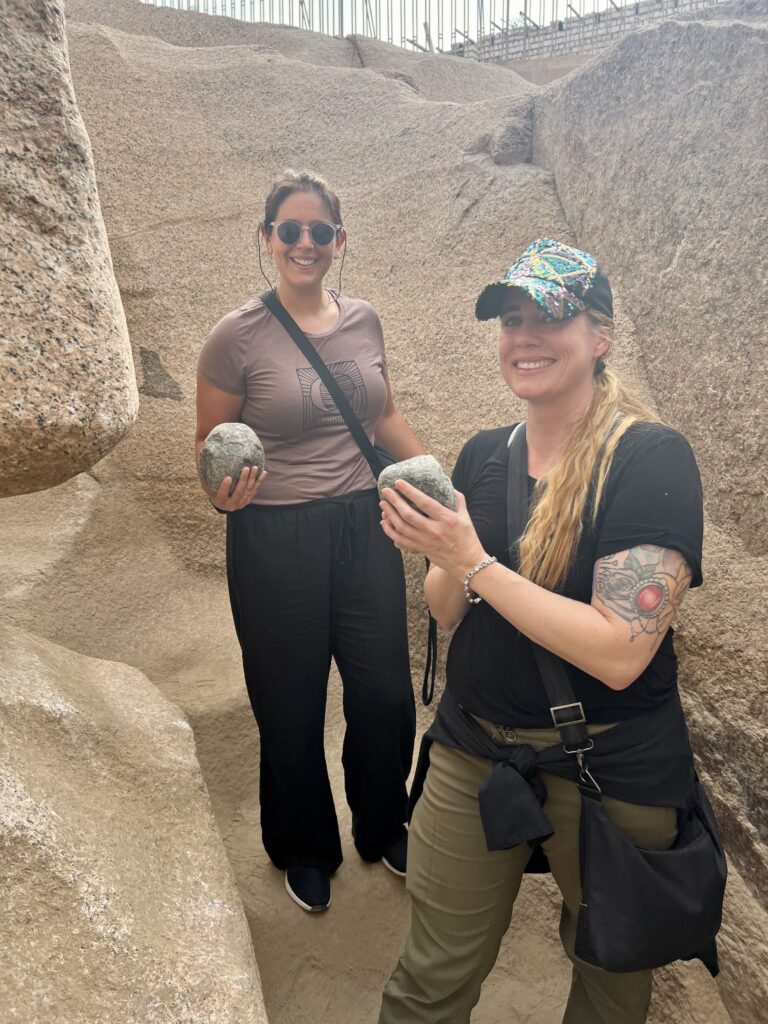
Our driver offered to take us to the Coptic Orthodox Cathedral of the Archangel Michael. We entered this newer church for free and received a tour in English for $1usd. It was again a private tour and completely unexpected. It has been built solely off donations and isn’t completed yet. It has tall ceilings and many references to religious figures in the construction, paintings, carvings. It holds 3,000 people and is quite a site to see. The tour consisted of learning about the symbolism of the carvings, paintings, gorgeous dome ceiling, as well as the dimensions and capacity. It was a nice little addition to the day.



We came back to the hotel and still had a lot of time to kill so we went to the Bazaar just up the street. It was chaos of booths upon booths and block upon blocks of vendors, all trying to sell you tourist gifts, spices, home items, clothing, shoes, bags, etc… we wound up haggling with a guy for t-shirts and spent a lot of time dodging other vendors. A good tip is to mention you already bought something, this seems to stop them the easiest. Otherwise, you just need to put on blinders and make no eye contact. Children also approach you to sell items or grab you. A lot of stuff was different and geared to locals but it was pretty much the same gifts we have been seeing everywhere else and the prices weren’t necessarily good.
We went back to the hotel and showered, it’s hot and surprisingly humid so sweating is unavoidable. We meet up with the group at 5pm for a boat ride to a Nubian village for dinner. Our host met us at the dock and sailed across with us. We walked through town and we sat on the rooftop of the house and had a traditional Nubian meal: potatoes in sauce, lentil soup, okra, grilled chicken, egg pie, Nubian bread, eggplant and raw veggies. Our host told us about his culture and gave an opportunity to ask questions. Interestingly, Nubian is only a spoken language and not written. There are two different tribes that speak completely different languages. They trend to marry other Nubians but a lot of times from different tribes and in other locations. It was informative and we felt very welcome. We headed back across the Nile river and fought our way across the wild traffic back to the hotel.

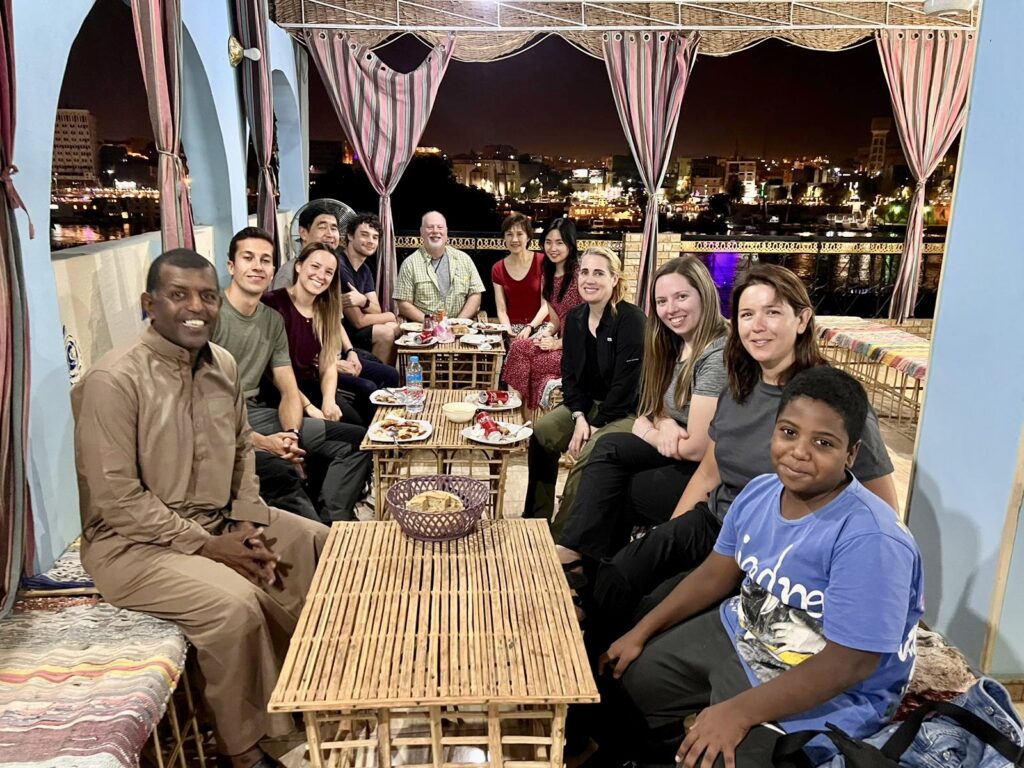

Egypt has very little order when it comes to driving. 3 lane roads with have 5 rows of cars. Turning cars will eventually just throw themselves in front of traffic to go. The buses are more aggressive when it comes to this because no one is going to “let” the cross. Pedestrians are similar but tend to look for small openings and start to cross. Sometimes they even stop between cars in the middle of the road and wait for the next opening. Locals say there are rarely accidents, but every car has scrapes, dents, etc so evidently they don’t consider those “accidents”. This was the first time we successfully had to cross a busy road and we SURVIVED! haha.
Day 6 Aswan
I started my day at 3:30. We had a 5am departure. We loaded onto the bus with our provided box breakfast and bag of snacks. We drove 4 hours to Abu Simbel: Abu Simbel refers to an archaeological site in southern Egypt that houses two massive rock temples. Here’s a brief description: Location: Abu Simbel is located near the border with Sudan, on the western bank of Lake Nasser, close to the town of Abu Simbel. Temples: The site comprises two temples carved into the mountainside during the reign of Pharaoh Ramesses II in the 13th century BCE. The Great Temple is dedicated to Ramses II, while the smaller temple is dedicated to his wife, Queen Nefertari. Construction: The temples were originally situated on the banks of the Nile but were relocated in the 1960s to avoid submersion by the rising waters of Lake Nasser following the construction of the Aswan High Dam. Architectural Marvel: The Great Temple of Abu Simbel is particularly renowned for its colossal statues of Ramses II at the entrance, depicting him seated on a throne. The interiors of both temples are adorned with intricate reliefs and carvings. Solar Alignment: Twice a year, in February and October, the sun’s rays penetrate the inner sanctum of the Great Temple, illuminating statues of the gods seated within, including a statue of Ptah. UNESCO World Heritage Site: Abu Simbel, along with other Nubian monuments, is designated as a UNESCO World Heritage Site known as “Nubian Monuments from Abu Simbel to Philae.” Abu Simbel stands as a testament to ancient Egyptian architectural prowess and the monumental efforts undertaken to preserve its heritage in the face of modern development. It is a popular tourist destination and a symbol of international collaboration in safeguarding cultural treasures. More information can be found here: https://www.britannica.com/place/Abu-Simbel




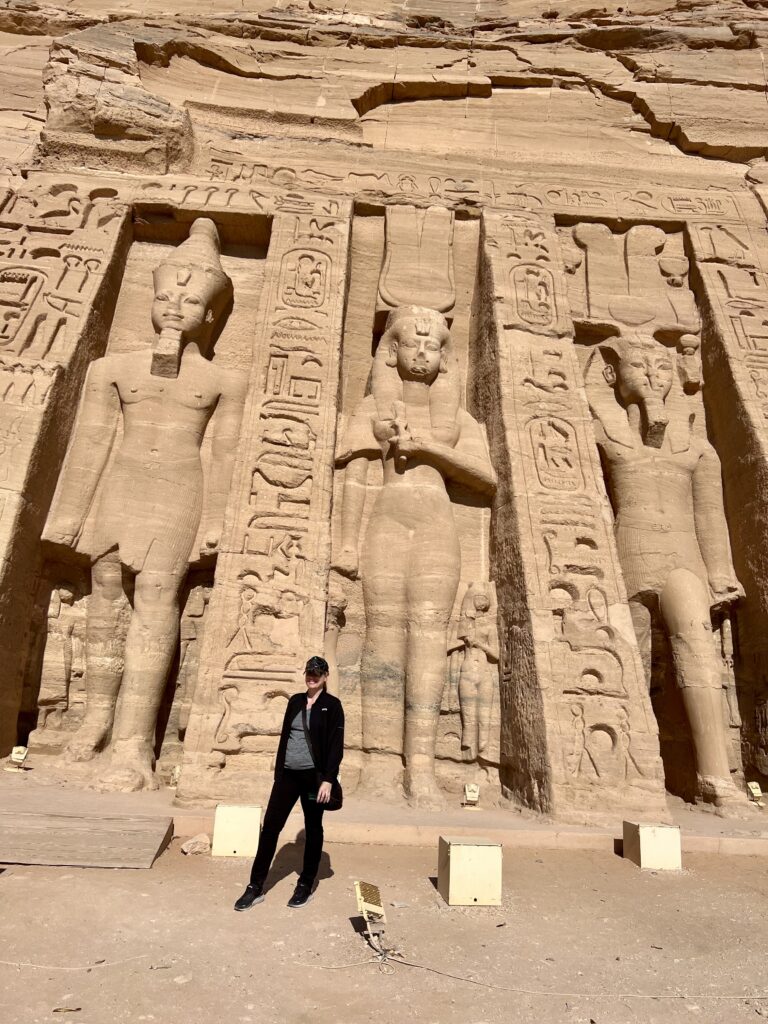
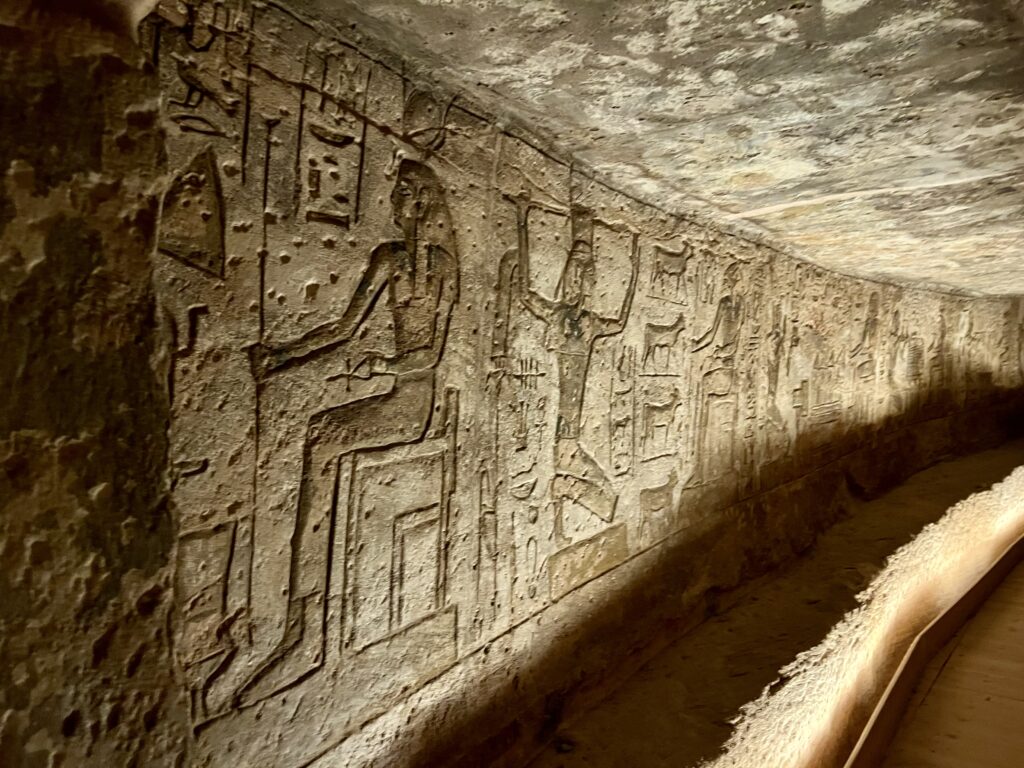


It was quite impressive knowing that these were moved piece by piece to preserve it when the new dam was installed. They also made manmade mountains to replicate how they were found. The temples are truly massive and quite worth the detour. The site has a bazar which is unavoidable as it’s the only exit so be prepared for the onslaught of sellers yelling and pushing you to buy. “Everything is $1”, “everything is free”, “hassle free shop”… will be repeated over and over. Note: if you find a seller that you are interested in purchasing from and saw something somewhere else, they can probably get you the other item. It is cheaper to buy more than one item, so try to just buy from one seller to get the best deal. You also need to haggle, it’s expected so MOST will quote high. I did buy one item for $2usd that was a small camel which didn’t seem worth the haggle, this seller wasn’t aggressive and gave a fair price for what I bought.
We settled in for a 4 hour drive back to the hotel and had free time. Our small group had pre decided to eat at the Old Cataract Hotel: An iconic hotel, built on a granite cliff facing Elephantine Island in 1899. A three-year makeover by the Sofitel chain has reduced the number of rooms by half and increased the proportion of suites. The colonial-era palace has 76 rooms with gold and maroon interiors and sunset Nile views; the modern tower wing has 62 rooms, all with Nile-facing balconies, and a sumptuous new spa. Rooms have deep tubs or rain showers, all with Hermès toiletries. If you’ve ever been tempted to pack a vintage tuxedo or evening gown, this place provides the perfect backdrop. The restored 1902 restaurant, modeled after Cairo’s Ibn Tulun mosque, looks like a film set for Death on the Nile. Art Deco meets Mamluk glamour in the chandeliered palace, its halls adorned with photographs of royals, artists, and other luminaries who’ve stayed here. The tower’s contemporary decor echoes ancient Egyptian motifs. https://www.cntraveler.com/hotels/egypt/aswan/old-cataract-hotel
It was the muse for Agatha Christie’s Death on the Nile. Agatha stayed at the hotel for almost a year and you can rent her room for $5000 usd/night. The hotel is beautiful. We sat on the Terrace and had a wonderful view for sunset with a pool on a lower level and the Nile River below that. It was such a great way to spend the evening with old and new friends. Eventually, the rest of our tour group made their way there and enjoyed a meal. As we left in the darkness, the front was lit up with Christmas decorations and we got some great photos. I recommend checking the place out.
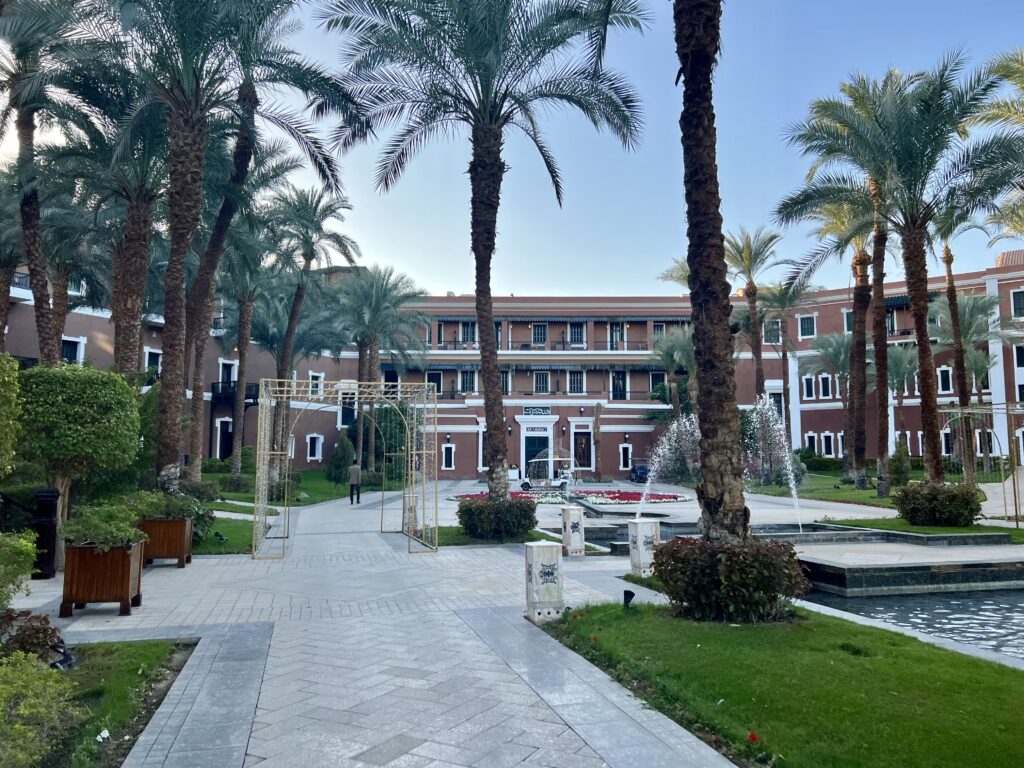


Notes: I called the Cataract Hotel when we arrived back in Aswan, they initially told me, non hotel guests were not able to eat there but then the person said “hold on”. When she returned, we had the option to eat at the 1408 after 7pm when it opens for dinner and one other restaurant for the dinner hour. It was 3pm and we didn’t eat lunch. We were told that high tea was available anytime before 7pm so that’s what we arrived to try. We decided to look up other restaurants along the walk back to get a real meal after the tea and snacks. When we arrived, we were provided the full lunch menu and were able to order whatever we wanted. We had to sit in the side portion of the restaurant as the main was reserved for guests. The staff was accommodating. I do suspect this is in part due to tourism being down from the war in Israel but we were pleasantly surprised. FYI: the high tea menu was also very good so don’t be afraid to come here for that. We drank a coke, ate an entree and dessert and it was approx $50 usd/person.
We walked back along the Nile River and took a photo at the Aswan sign before heading to the hotel to relax before another really long day tomorrow.
Day 7. Aswan to Luxor
We started breakfast at 7am and had to be down in the lobby at 8:30 am with our luggage in hand. We left the luggage in the hotel lobby and walked across the street to catch a felucca (boat with a sail). Ours required us to remove our shoes and had a foam covering over the entire boat so we were able to lay down, sit, sleep. We had a relaxing ride down the Nile for 3ish hours. A motorboat occasionally came by so we could transfer onto it to use the bathroom. At the end, we loaded the motorboat and had a lunch on board. Then docked at the dam where a tour bus had our luggage on board.



We then road for about an hour to Kom Ombo Temple. Kom Ombo Temple is an ancient Egyptian temple located in the town of Kom Ombo, along the Nile River in Upper Egypt. Here’s a brief description: Dual Temple: Kom Ombo is unique because it is a double temple, meaning it has two sets of sanctuaries and halls dedicated to different deities. One side is dedicated to the falcon-headed god Horus (Harwer), and the other side is dedicated to the crocodile-headed god Sobek. Construction: The temple dates back to the Ptolemaic period (180–47 BCE) and was later expanded during the Roman period. The construction of the temple continued intermittently over several centuries. Architectural Features: The temple exhibits traditional Egyptian architectural elements, including pylons, courtyards, hypostyle halls, and sanctuaries. The reliefs and carvings depict various scenes related to religious rituals, deities, and daily life. Crocodile Museum: The site also features a Crocodile Museum that displays mummified crocodiles, emphasizing the association of Sobek with these creatures. Healing Center: Kom Ombo Temple was considered a center for healing, and it is believed that pilgrims visited the temple seeking cures for ailments. Location: The temple is strategically situated along the Nile, and its location has archaeological significance in the study of ancient Egyptian trade routes and river transport. Kom Ombo Temple’s dual dedication to Horus and Sobek, along with its well-preserved reliefs, makes it an interesting archaeological site. Visitors can explore its unique structure and learn about the religious practices and beliefs of ancient Egyptians. More information here: https://www.ancient-egypt-online.com/kom-ombo.html
It was quite a site to see and we spent an hour or so wandering around. They also had a mummified crocodile museum which had several sized crocodiles inside.









We boarded our bus and started the 5 hour drive to Luxor. It is bumpy and not the most pleasant drive as it is not a traditional highway. Once in town, we had dinner at a place included with our tour: grilled chicken and rice. 😑. I’m sick of grilled chicken and rice. We checked into the hotel and hit the bazar. The sellers were a bit aggressive with pet names, “helllllo’s”, “everything is free”, “everything is 99% off”, etc… but we managed to find sellers that left us alone so we spent time in their shops and found a few good deals. We then headed back to the hotel and went to bed.
Day 8: Full day in Luxor
We ate breakfast at 6:30am and saw the sky filled with hot air balloons from the balcony of the dining room. Then we met the group at 7:30 am. We headed to our big tour bus and drove to an area on the Nile. We took a super short ride across the Nile and were picked up by another smaller bus. We drove to a small village called Kurna Al Boaairat to meet with the members of Funtas/a, a nonprofit that teaches children in the community about growing plants, English, art and many other life skills. We rode bikes through the village and then sat and talked with the volunteers for a bit.




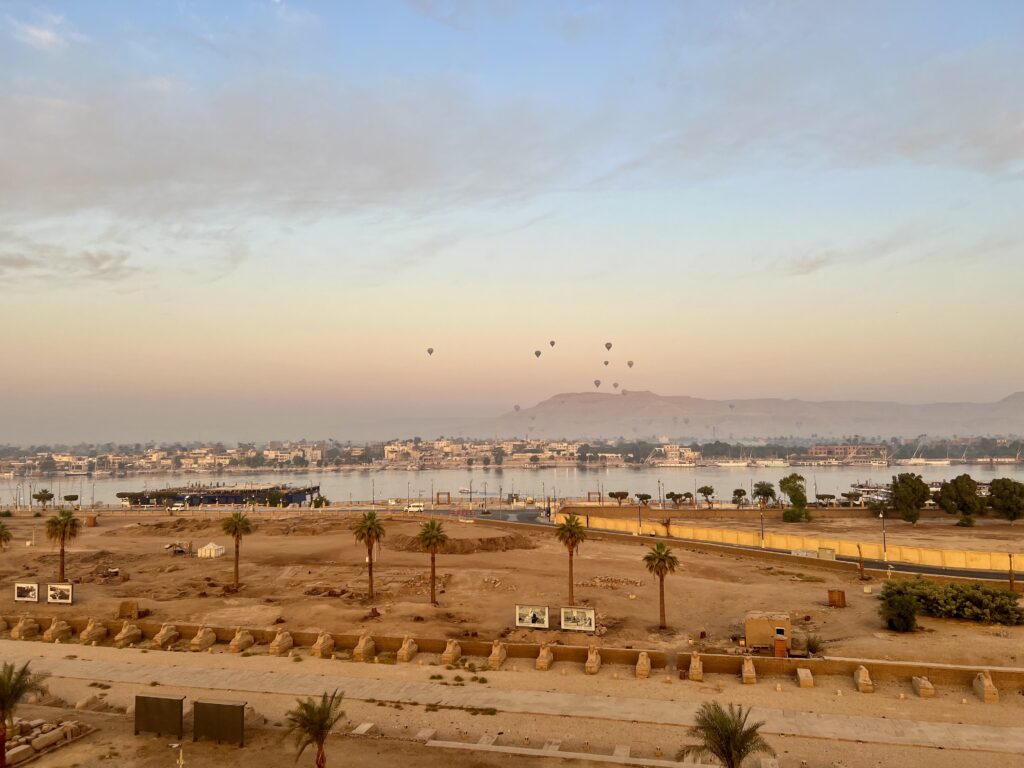
We loaded our smaller bus to meet up with the bigger one and headed to Hatshepsut Temple: The Mortuary Temple of Hatshepsut, also known as Djeser-Djeseru, is an ancient Egyptian temple located on the west bank of the Nile near Luxor. Constructed during the 15th century BCE, it was dedicated to the female pharaoh Hatshepsut and served as a funerary monument.
Designed by the architect Senenmut, the temple is characterized by its unique terraced architecture, with colonnaded halls and sculptures depicting the pharaoh’s divine birth and achievements. After Hatshepsut’s death, her successor, Thutmose III, attempted to erase her legacy, leading to significant damage and destruction of the temple. In the 20th century, archaeological efforts and restoration projects have unveiled and preserved the temple, making it one of the most iconic structures of ancient Egypt and an important historical and architectural site. More information here: https://en.m.wikipedia.org/wiki/Mortuary_temple_of_Hatshepsut
When we arrived, we rode golf carts to get closer to the temple and then hoofed it. The temple is 3 stories and yet again impressive in size. This is also an active excavation site where they are still making more discoveries. We spent about and hour here and moved onto the next location.









Valley of the Kings: Valley of the Kings, long narrow defile just west of the Nile River in Upper Egypt. It was part of the ancient city of Thebes and was the burial site of almost all the kings (pharaohs) of the 18th, 19th, and 20th dynasties (1539–1075 BCE), from Thutmose I to Ramses X. Located in the hills behind Dayr al-Baḥrī, the 62 known tombs exhibit variety both in plan and in decoration. In 1979 UNESCO designated the valley part of the World Heritage site of ancient Thebes, which also includes Luxor, the Valley of the Queens, and Karnak. The kings of the New Kingdom (c. 1539–1075 BCE), fearing for the safety of their rich burials, adopted a new plan of concealing their tombs in a lonely valley in the western hills behind Dayr al-Baḥrī. There, in tombs sunk deep into the heart of the mountain, pharaohs were interred, as were several queens, a few officials of high rank, and the numerous sons of Ramses II. The plan of the tombs varies considerably but consists essentially of a descending corridor interrupted by deep shafts to baffle robbers and by pillared chambers or vestibules. At the farther end of the corridor is a burial chamber with a stone sarcophagus in which the royal mummy was laid and store chambers around which furniture and equipment were stacked for the king’s use in the next world. https://www.britannica.com/place/Valley-of-the-Kings
We once again arrived at the visitor center where there is an interesting display of the layout and 3D image of all the burial chambers and how deep they are located. We hopped on more golf carts and rode closer to the site. During our visit we were able to pick 3 of 4 included tombs:
Rameses IV: The tomb of Rameses IV (KV2) in the Valley of the Kings is one of the well-preserved tombs from the 20th dynasty. Rameses IV, a pharaoh of ancient Egypt, ruled during the 12th century BCE. The tomb features a descending corridor, a long corridor with side chambers, and a burial chamber. The burial chamber contains the sarcophagus and decorations depicting religious scenes and texts from the Book of the Dead. Despite being less ornate compared to some other tombs, it offers valuable insights into the religious beliefs and burial practices of the time. Rameses IV, who reigned during the 12th century BCE, is primarily known for his contributions to the architecture and construction of various temples and structures in ancient Egypt. He continued the monumental building projects initiated by his predecessors, emphasizing devotion to the gods and asserting his royal authority. While he didn’t engage in major military campaigns, Rameses IV played a significant role in maintaining the stability and grandeur of the New Kingdom during his brief reign. https://en.m.wikipedia.org/wiki/Ramesses_IV
This tomb was quite large and not very deep. It has a long hallway, the walls still have color but not as much as other tombs we’ve visited.


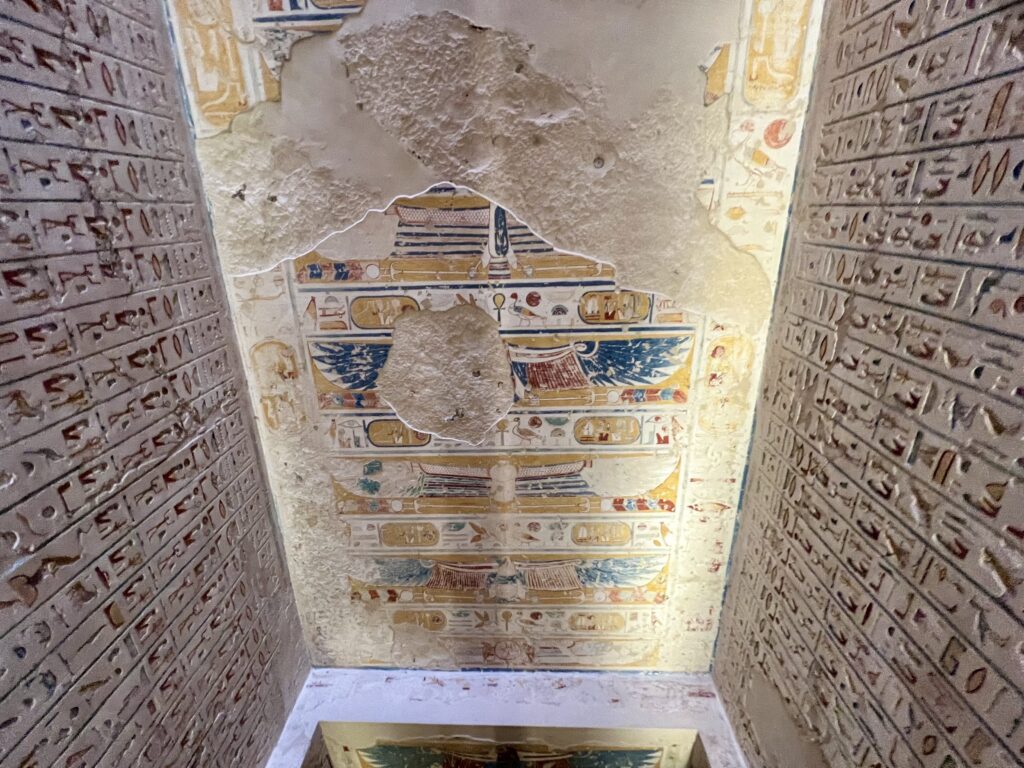

Rameses I: Rameses I, the founding pharaoh of the 19th dynasty, has a tomb designated KV16 in the Valley of the Kings. His reign was relatively short, from 1292 to 1290 BCE. The tomb, discovered by Giovanni Battista Belzoni in 1817, consists of a descending corridor, a well room, and a burial chamber. Despite being modest in size compared to later tombs, KV16 features well-preserved decorations portraying scenes from the Book of Gates and other funerary texts. The tomb reflects the early stages of the elaborate burial traditions that would become characteristic of later pharaohs in the Valley of the Kings. Rameses I, originally named Paramessu, rose to prominence as a military commander and later became the pharaoh of Egypt. He founded the 19th Dynasty and ruled for a brief period from 1292 to 1290 BCE. Rameses I played a crucial role in the military campaigns of Seti I, his son and successor. While his reign was relatively short, he initiated a line of pharaohs that included significant figures like Seti I and Rameses II, who left a lasting impact on Egypt’s history and architecture. https://en.m.wikipedia.org/wiki/Ramesses_I
This one had a much steeper entrance with an intense set of stairs. The chamber was small but very colorful. The chamber was a bit crowded so you have to spend a bit of time down here to get some pictures without people.



Ramesses IX: Rameses IX, the eighth pharaoh of the 20th Dynasty, has a tomb designated KV6 in the Valley of the Kings. His reign occurred during the 12th century BCE. The tomb has a long corridor leading to a series of chambers, including an antechamber and a burial chamber. The burial chamber contains a red quartzite sarcophagus and scenes from the Book of Gates. Rameses IX’s reign faced economic challenges and internal unrest, but his tomb provides insights into the continuation of royal burial traditions and religious beliefs during the declining years of the New Kingdom. Rameses IX, also known as Neferkare Setepenre, was the eighth pharaoh of the 20th Dynasty in ancient Egypt. He ruled from around 1126 to 1108 BCE during a time marked by economic difficulties and internal unrest. Rameses IX continued the burial traditions of his predecessors, constructing his tomb in the Valley of the Kings, where he was laid to rest. Despite the challenges of his reign, the tomb and its decorations offer valuable insights into the religious and funerary practices of the time. https://en.m.wikipedia.org/wiki/Ramesses_IX
This tomb was the biggest of the free ones and had three corridors. The vestibule and a pillared hallway. It also had quite a bit of color.





The site also had additional tombs to see for an extra cost of 180 EGP-1800EGP. We didn’t opt to see any of the extras as we planned to see other tombs this day. We then loaded the bus and headed to Colossi of Memnon: “The Colossi of Memnon (also known as el-Colossat or el-Salamat) are two monumental statues representing Amenhotep III (1386-1353 BCE) of the 18th Dynasty of Egypt. They are located west of the modern city of Luxor and face east looking toward the Nile River. The statues depict the seated king on a throne ornamented with imagery of his mother, his wife, the god Hapy, and other symbolic engravings. The figures rise 60 ft (18 meters) high and weigh 720 tons each; both carved from single blocks of sandstone. They were constructed as guardians for Amenhotep III’s mortuary complex which once stood behind them. Earthquakes, floods, and the ancient practice of using older monuments and buildings as resource material for new structures all contributed to the disappearance of the enormous complex. Little of it remains today except for the two colossal statues which once stood at its gates.” https://www.worldhistory.org/Colossi_of_Memnon/ (more information can be found here). This was a free and very quick stop. The only area accessible is in front of the statues and a bit around the side. It is also located right next to the oldest (surviving) village (per our driver). No one lives there any more because they suspect it’s on top of other tombs. There is also a ticket office that you need to purchase tickets to the smaller, lesser known attractions but I warn you… you won’t know it’s a ticket counter just by looking at it. This stop was quick and we were off to lunch in a neighboring village. We again were prepared food by a local family. That concluded our group tour for the day.



However, as a group we decided that we wanted to see more on the West Bank of Luxor ahead of time and asked our tour guide to arrange private transportation. He arranged a van to take us to more destinations and then drive us back to the hotel for 200EGP each. We loaded our van and headed to that small ticket office to purchase a tickets. We then headed out to the Valley of the Queens: The Valley of the Queens, also known as Biban el Harim, is situated on the west bank of the Nile, opposite the ancient city of Thebes. It gained prominence during the New Kingdom (c. 1550–1070 BCE) as a burial ground for queens, princesses, and high-ranking officials. The valley contains over 90 known tombs, although not all are royal. One of the most famous tombs in the Valley of the Queens belongs to Nefertari, the Great Royal Wife of Ramesses II. Her tomb, designated QV66, is renowned for its exquisite and well-preserved wall paintings depicting scenes from the Book of the Dead and other religious texts. The elaborate decorations highlight the importance of the afterlife in Egyptian beliefs. While not as extensive as the nearby Valley of the Kings, the Valley of the Queens provides valuable insights into the role and status of royal women in ancient Egyptian society, as well as the evolving artistic styles during the New Kingdom.. more information provided here: https://www.historyskills.com/classroom/ancient-history/valley-of-the-queens/



They had Queen Nefertari’s tomb available as an add on for 2000EGP which is supposed to be the most elaborate and beautiful of all the tombs in Egypt. Despite being dead, the guard wouldn’t take a bribe so none of us forked over the cash. However, three tombs were included: Prince Kha Em Wast: Prince Khaemwaset, also known as Khaemweset or Khaemwaset, was an ancient Egyptian prince during the 19th dynasty (c. 1292–1189 BCE). He was the fourth son of Pharaoh Ramesses II and Queen Isetnofret. Khaemwaset is particularly noted for his role as a high priest of Ptah in Memphis and his interest in preserving and restoring ancient monuments, especially during the reign of his father.
Khaemwaset is often referred to as the first Egyptologist due to his efforts to catalog and repair decaying temples and monuments. His legacy is connected to his dedication to the cultural and architectural heritage of ancient Egypt. The tomb had a lot of color and engraved symbols. Most were behind glass. It had a corridor, 2 side chambers and another corridor. The biggest perk was that we essentially had the tomb to ourselves.
The next tomb was Titi: Titi (Tomb QV52) in the Valley of the Queens is believed to be the burial place of a secondary wife or concubine of Ramesses III, a pharaoh of the 20th Dynasty of ancient Egypt. Not much is known about Titi, and her tomb is relatively small compared to some of the more prominent queens and princesses buried in the Valley of the Queens. The Valley of the Queens served as a burial ground for queens, princesses, and other female members of the royal family during the New Kingdom period. While some tombs are more famous for their elaborate decorations and connections to well-known historical figures, others, like Titi’s, may have simpler designs and fewer inscriptions. This tomb had chambers with very short ceilings: beware if you are tall. The colors are a bit more muted but still present. Again most of the carvings are behind glass and also we had the tomb to ourselves.
The last tomb was of Prince Amenherkhepshef: Prince Amenherkhepshef, also known as Amun-her-khepshef or Amenhir-khepeshef, was one of the sons of Ramesses III, a pharaoh of the 20th Dynasty of ancient Egypt. As a member of the royal family, Amenherkhepshef held the title “King’s Son of His Body,” indicating his status as a direct son of the reigning pharaoh. Notably, Amenherkhepshef was involved in the famous Harem Conspiracy during the reign of his father. The conspiracy aimed to place him on the throne, but it ultimately failed. As a result, Amenherkhepshef and several others were implicated, and some were subjected to punishment. Despite the political turmoil, Amenherkhepshef is remembered through inscriptions and historical records that provide insights into the dynamics of the royal family during the New Kingdom period in ancient Egypt. This tomb was the grandest of the free tombs. It has 3 chambers with vibrant color in 2 of them. It has a sarcophagus. There is also a mummified fetus. The sarcophagus is behind glass and hard to photograph even with having the tomb to ourselves.
Overall, the Valley of the Queens a bit less impressive than the Valley of the Kings but it was significantly less crowded which is an ultra perk.




Our next stop is probably the most underrated thing that we did in Egypt. It rarely gets tourists and I have no idea why because it was one of our overall favorites. It is very close to both Valley of the Kings and Valley of the Queens. It was called Deir el-Medina: Deir el-Medina is an ancient Egyptian village situated on the west bank of the Nile River, across from modern-day Luxor. It was primarily inhabited by the skilled workers and artisans who built the tombs in the nearby Valley of the Kings and the Valley of the Queens. The village dates back to the New Kingdom period, specifically the 18th through the 20th dynasties (c. 1550–1070 BCE). The residents of Deir el-Medina, often referred to as “the Royal Artisans,” were responsible for constructing and decorating the tombs of pharaohs and other nobles in the surrounding valleys. The village provides valuable insights into the daily lives, working conditions, and religious practices of the skilled laborers and artists of ancient Egypt. The site has yielded a wealth of archaeological finds, including well-preserved houses, administrative buildings, and thousands of ostraca (inscribed pieces of pottery), offering a remarkable glimpse into the social and cultural aspects of this community. This place requires a ticket purchased at the little ticket booth. They didn’t have a booth there but I’m sure they would figure out a way to let you in. They also can be purchased on www.egymonuments.com. We were met by the Archaeologist in charge of the excavations. He lives onsite and has a lot of information about the site. They also have 3 tombs open to the public, one that has only been open for a few years. They are working on several more. The site also has a temple that is remarkable and a 100m pit where they excavated multiple artifacts from and the ruins from the village that once occupied the area.
The first tomb we went into was The tomb of Inherkha whom was an Ancient Egyptian artisan who lived during the 19th Dynasty, around 1292–1189 BCE. His tomb, designated as TT359, is known for its well-preserved decorations and scenes depicting various aspects of daily life, religious rituals, and funerary practices. The wall paintings in the tomb provide insights into the cultural and religious beliefs of the time. Scenes typically include depictions of Inherkha and his family, offerings to the deceased, and religious ceremonies. The tombs in Deir el-Medina often served not only as burial places but also as a means for the deceased to continue their existence in the afterlife. This tomb requires a lot of stairs and “watch your heads” from the guide. It has a lot of yellow and black color. An antechamber and stairs down to a burial chamber.


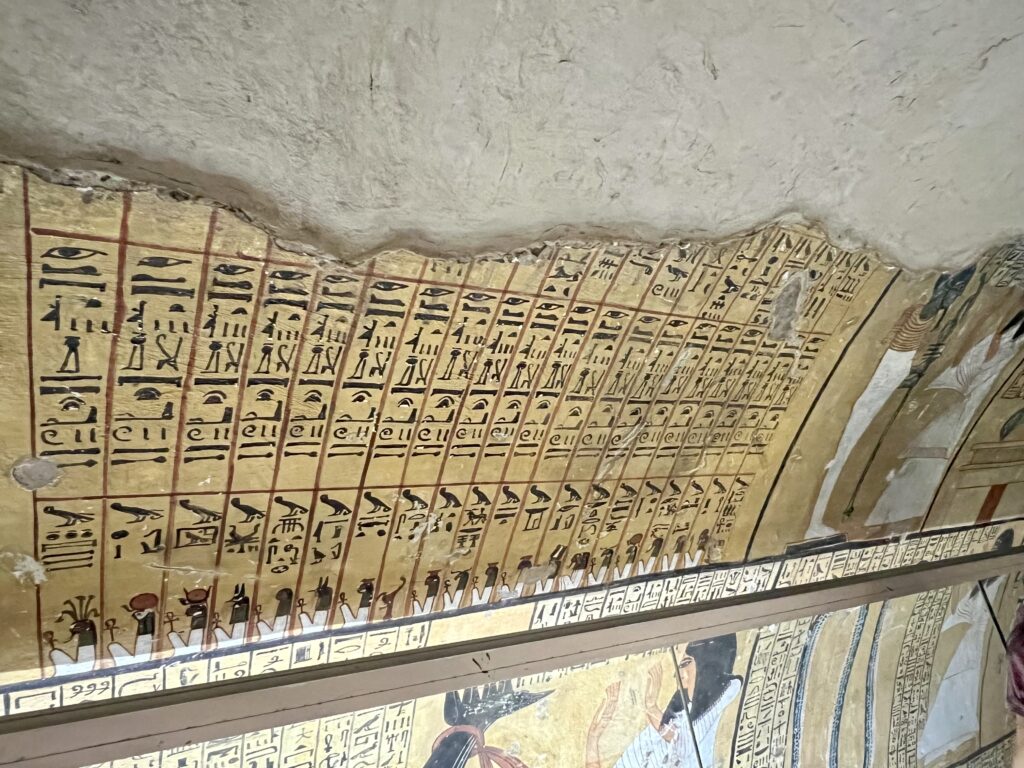

The next one wasn’t marked and is the newest open tomb. It was the grandest. It had really low passages you needed to crawl or squat through. It was vibrant with a lot of reds and yellows. It has a large chamber and the stairs down into two separate smaller chambers.
The last one was the tomb of Sennutem: also known as Sennedjem was an ancient Egyptian artisan who lived during the 19th Dynasty, around 1292–1189 BCE. Sennedjem’s tomb, designated as TT1, is celebrated for its vivid and well-preserved wall paintings. These paintings depict scenes of everyday life, religious ceremonies, and the journey of the deceased into the afterlife. The tomb provides valuable insights into the beliefs and practices of the people living in Deir el-Medina, who were responsible for constructing the royal tombs in the nearby Valley of the Kings. It was the smallest but still very colorful. It was also a bit easier to navigate physically.


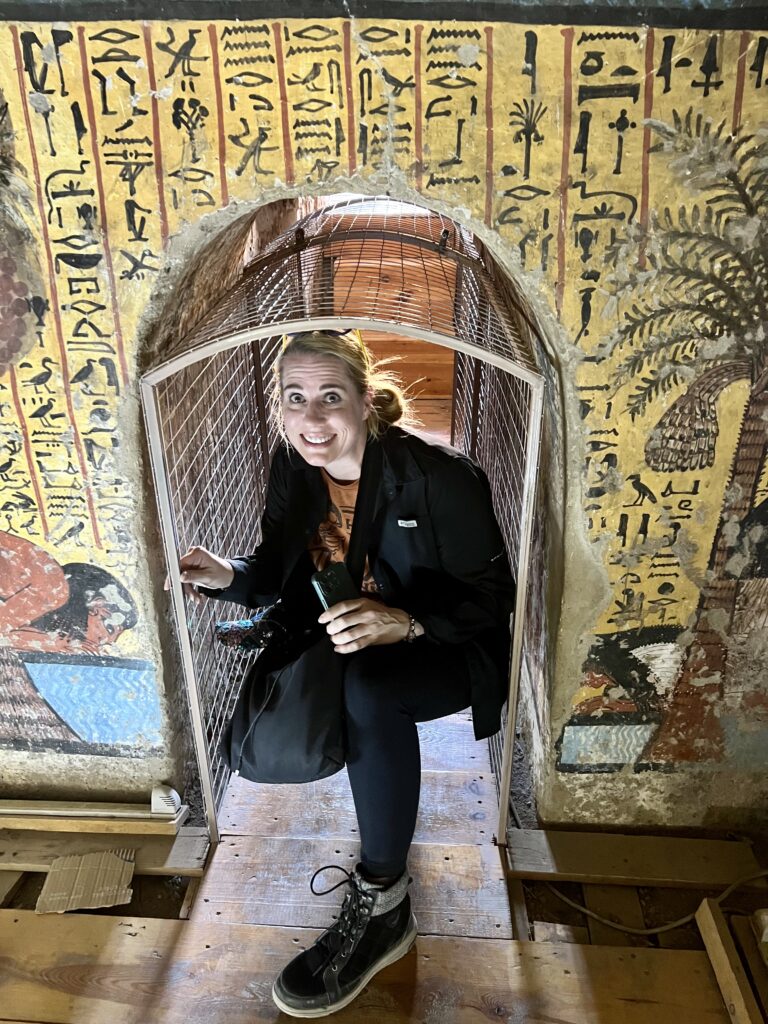

After the tombs, we took a guide and walked to the This temple, known as the Ptolemaic Temple of Deir el-Medina, dates to the Ptolemaic period (c. 305–30 BCE) and later Roman times. The temple is dedicated to various deities, including Hathor, the goddess of music, dance, and love, and Amenhotep I, a pharaoh of the 18th Dynasty. It consists of a small courtyard, a hypostyle hall with columns, and sanctuaries dedicated to different gods. The temple was likely used for religious ceremonies and rituals by the inhabitants of Deir el-Medina. While not as grand as some of the larger temples in Egypt, the Temple of Deir el-Medina is significant for its connection to the workers who built the royal tombs and offers insights into the religious practices of the time. Archaeological excavations have revealed various artifacts and inscriptions, contributing to our understanding of daily life and spirituality in ancient Egypt.
This temple was in excellent condition: It has a lot of vibrant color including some gold which we’ve yet to see at any previous place. There is quite a bit of blue and red remaining and the engravings are mostly intact. We were lucky to have been allowed up the stairs to the roof. We also had the entire temple to ourselves which was remarkable. The tour continued to a 100m pit that was created while excavating artifacts. They have a pile of broken pottery next to the pit, many items were discovered here and helped clear up some historical information.

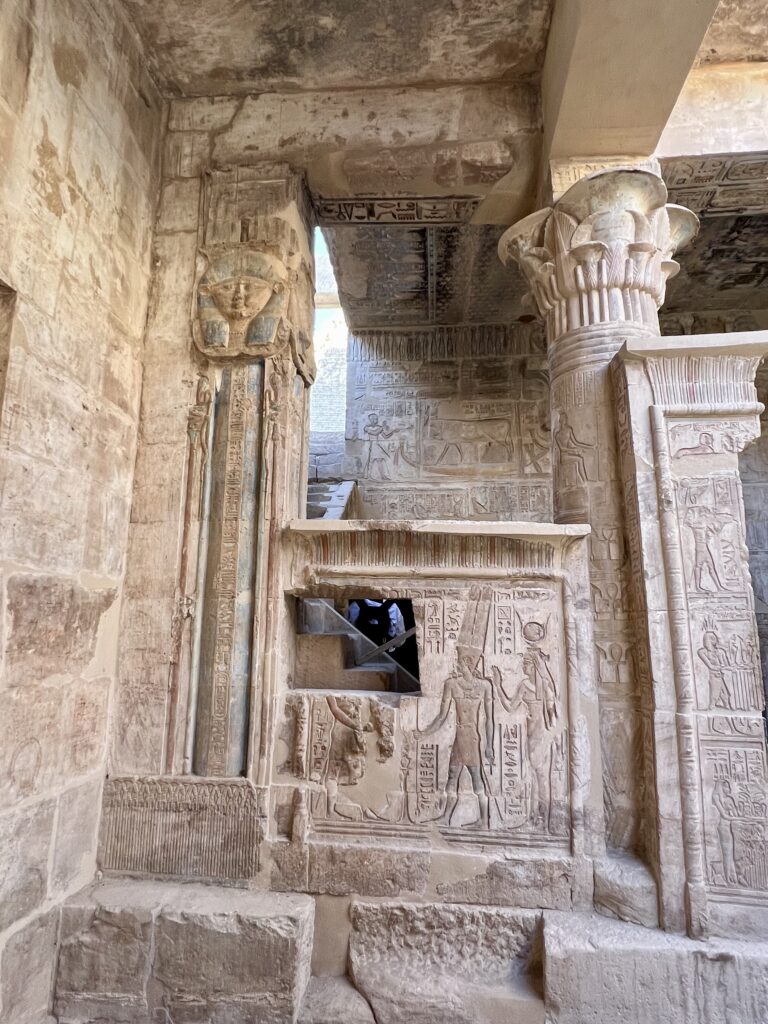







After that site, we hopped in the van and took the “not yet opened bridge” back to the city which saved us a bit of time. We made it to the rooftop of our hotel to catch the sunset as a group. We then went to a restaurant called Aboudi Coffee Break for Egyptian meat pies and dessert pies. They were fantastic, the services was a bit slow but we were a group of 9 and had plenty of conversation to occupy the time. We then took to the Brazar to finish our shopping lists and headed to the hotel.
Day 9: Luxor all day
we started leisurely at 8:30 am and hopped on the bus for Karnak Temple: Karnak Temple is one of the most significant and extensive temple complexes in Egypt. Located on the east bank of the Nile River, near Luxor, Karnak is a vast complex of temples, chapels, pylons, and other structures. It was dedicated primarily to the god Amun, but various pharaohs contributed to its construction and expansion over the centuries. Key features of Karnak Temple include: 1. Great Hypostyle Hall: This massive hall consists of 134 gigantic columns arranged in a grid pattern. The columns are adorned with intricate hieroglyphs and images. 2. Obelisks: Karnak has several obelisks, tall, narrow, tapering monuments. The most famous pair of obelisks still standing today was erected by Queen Hatshepsut. 3. Pylons: Large entrance gates or monumental doorways known as pylons mark the successive sections of the temple. The Karnak complex has several pylons built by different pharaohs. 4. Sacred Lake: A large artificial lake, known as the Sacred Lake, was part of the temple complex. It was likely used for ritualistic purposes, including purification ceremonies. 5. Avenue of Sphinxes: An avenue of human-headed sphinxes once connected Karnak Temple with Luxor Temple. Although much of it is now ruined, sections have been restored, providing a glimpse of its former grandeur. Construction at Karnak spanned several dynasties, with notable contributions from pharaohs like Senusret I, Amenhotep III, and Ramesses II. The temple complex served as a focal point for religious and administrative activities and played a crucial role in the religious landscape.



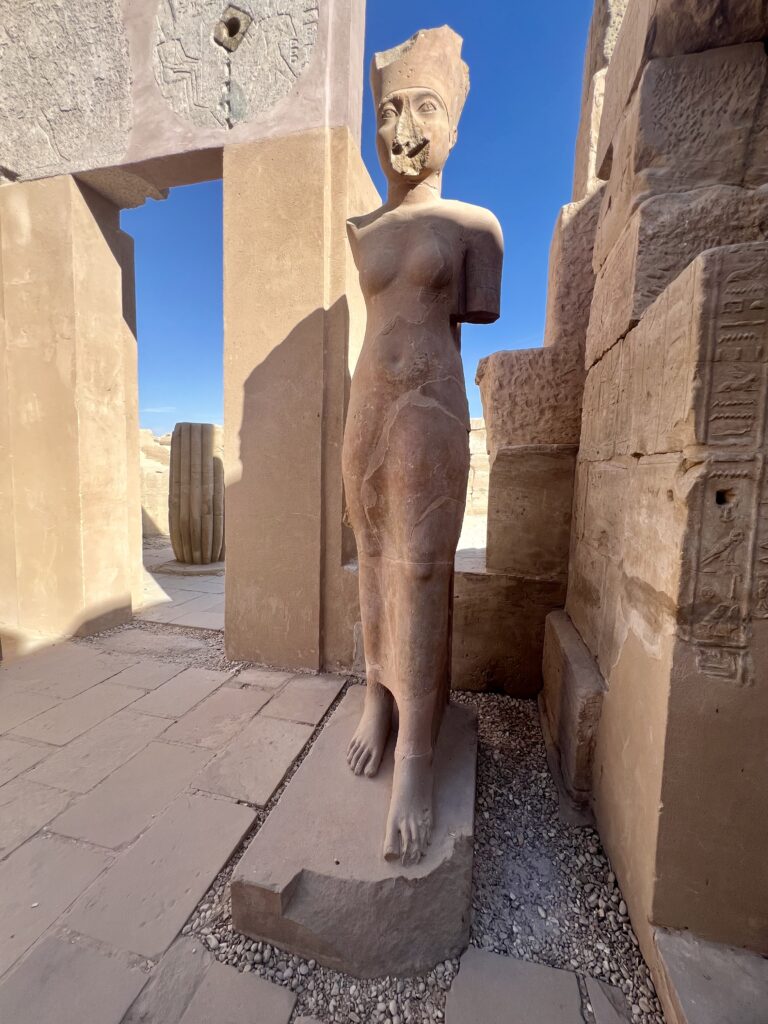
We made sure to head to the left toward the open air museum. We were some of the only ones and it was peaceful that way. The Karnak Open Air Museum is an extension of the Karnak Temple complex, located on its grounds in Luxor, Egypt. This museum showcases a collection of statues and artifacts discovered during excavations in and around Karnak Temple. It offers visitors a closer look at some of the smaller artifacts and pieces that have historical and archaeological significance.
Key features of the Karnak Open Air Museum include: 1. Statues: The museum houses a variety of statues, including depictions of pharaohs, gods, and other divine figures. These statues range in size from small to life-sized. 2. Stelae: Stone slabs or stelae with inscriptions and reliefs can be found in the museum. These stelae often carry religious, historical, or funerary texts. 3. Sphinxes: Some sphinxes, often associated with the processional ways and avenues leading to Karnak, are also on display in the open-air museum. 4. Architectural Fragments: Various architectural elements, such as column fragments, lintels, and other pieces from the temple complex, are exhibited. The open-air museum provides a more intimate experience for visitors to appreciate the details of the artifacts outside the vast Karnak Temple complex. It offers additional context to the rich history and religious significance of Karnak. As with many ancient Egyptian sites, the museum contributes to our understanding of the culture and practices of the time. It was well worth the extra time.




We also made sure to hit the Temple of Khonsu: Khonsu was an ancient Egyptian god associated with the moon, time, and healing. The construction of this temple was initiated by Ramesses III of the 20th Dynasty and continued by subsequent pharaohs.
Key features of the Temple of Khonsu include: Purpose: The temple was dedicated to the worship of the god Khonsu, who was considered a member of the Theban Triad, alongside Amun and Mut. Architecture: Like many Egyptian temples, the Temple of Khonsu follows a traditional design with an entrance pylon, courtyard, hypostyle hall, and sanctuaries. The hypostyle hall is adorned with reliefs depicting the pharaoh in various religious and ceremonial scenes. Decorations: The walls of the temple are decorated with intricate carvings and reliefs. These depict offerings to the gods, scenes of the pharaoh engaging in rituals, and representations of Khonsu. Courtyard: The courtyard of the temple is surrounded by columns and is thought to have been used for various religious ceremonies and rituals. Processional Way: A processional way connects the Temple of Khonsu with the larger Karnak Temple complex. This route was likely used for religious processions and festivals. The Temple of Khonsu, while smaller in scale compared to some other structures within Karnak, is significant for its religious and historic al importance. It reflects the architectural and artistic styles of the New Kingdom period and provides insights into the religious practices and beliefs of ancient Egyptians. The preservation of the temple allows modern visitors to experience the atmosphere of an ancient sacred space.
From there we headed to the Sphinx Avenue. It’s about 2.2 meters and connects Karnak Temple to the Luxor Temple. Note: once you get halfway, you have to purchase a ticket to the other temple. You may leave at the halfway mark but if you decide to do both, you will need to complete both prior to leaving the avenue.
Luxor Temple is an ancient Egyptian temple complex located on the east bank of the Nile River in Luxor, Egypt. It was constructed during the New Kingdom period and dedicated to the Theban Triad—Amun, his consort Mut, and their son Khonsu. The temple was primarily built by Amenhotep III (1392–1350 BCE) and later expanded by other pharaohs, including Tutankhamun, Horemheb, and Ramesses II. Key features of Luxor Temple include: 1. Great Court: The temple is entered through the Great Court, a large open space surrounded by a double colonnade with papyrus-bundle columns. 2. Colonnade of Amenhotep III: This section features a row of large open-flower papyrus columns. The northern part of the colonnade is known for the massive seated statues of Amenhotep III, known as the Colossi of Memnon. 3. Processional Colonnade: Connecting Luxor Temple to the Karnak Temple is an avenue of sphinxes, forming a processional way. While many sphinxes are missing, a significant restoration effort has been made to reveal its grandeur. 4. Hypostyle Hall: The hall is supported by columns with closed papyrus-bundle capitals. It contains scenes depicting religious rituals, including the Heb-Sed festival associated with the rejuvenation of the the pharaoh’s rule. 5. Sanctuaries: The inner sanctuaries were dedicated to the worship of Amun. The barque shrine, used to house the sacred boat of the god during festivals, is one of the notable features. Luxor Temple has undergone various modifications and additions throughout different periods, reflecting the changing religious and political landscape of ancient Egypt. The temple has been a site of worship for over 3,000 years and stands as a testament to the architectural and artistic achievements of the New Kingdom. Today, it is a UNESCO World Heritage Site and a popular tourist attraction.
Again, it was another massive temple. You just look around and wonder how it was constructed without modern tools. It’s hard to not look around in awe. This has marked Egyptian engravings and Roman influence in one temple.




From there, we decided to head to lunch. We picked an Italian restaurant which upon arrival was in the Sofitel Winter Palace hotel and also only open for dinner. They did have a poolside restaurant open. This was another luxurious hotel and the food was good. Just expect to spend over 500 EGP. We then walked back to the hotel to pack, relax and get ready for our last group dinner.
We really lucked out with our group. We all got along well. We all enjoyed seeing as much as we could and we all didn’t mind doing our own thing. We could independently exist and enjoyed each other’s company. Everyone was also on time and respected the group’s time. I usually opt out of group anything but really enjoyed my time with this group. The group dinner was spent at a little restaurant right around the corner from the hotel. We shared our favorite memories of the trip. We headed into the brazaar one last time and then went to bed.
Day 10: Luxor to Cairo.
We woke up the next morning and headed to the airport via bus. The security was no joke and you have to scan your bags and walk through metal detectors just to enter the airport. Then, we waited in line to drop our bags. There was another security check where they scan your carry ons and walk through a metal detector. All the while, they have men sitting at tables pulling passengers aside for additional random checks. It was still pretty quick and we got on the plane with little problems. When we arrived in Cairo, we said good bye to most of the group and headed off with David, Monica and Michael for one last day tour to Sakkara. Sakkara is an ancient archaeological site located in the vicinity of Cairo, Egypt. Saqqara is renowned for its vast necropolis, particularly the Step Pyramid of Djoser, which is considered one of the earliest monumental stone structures in Egypt. The Step Pyramid was built during the 27th century BCE for Pharaoh Djoser by his architect Imhotep. Saqqara served as a burial ground for the ancient Egyptian capital of Memphis and contains numerous tombs, mastabas, and other structures that showcase the evolution of Egyptian funerary architecture over the centuries. Saqqara is an essential historical and archaeological site, reflecting the rich cultural and architectural heritage of ancient Egypt. It has been a UNESCO World Heritage Site since 1979.
You are able to walk around the pyramid and they have a smaller one on site that you can enter the chamber of, it’s not a very difficult walk to enter the pyramid and it’s free. However, it is only available for certain hours in the morning so be sure to check and plan accordingly. The site also has some tombs that you can enter. It’s a pretty cool stop and we spent about an hour to an hour and half here.







We loaded the bus and headed to one last destination: Memphis.
Memphis was the ancient capital of Egypt and a significant political, economic, and religious center. Located near present-day Cairo, Memphis was founded around 3100 BCE and served as the capital for several dynasties during the Old Kingdom. The city held a prominent position along the Nile River and played a crucial role in the development of ancient Egyptian civilization. One of the key features of Memphis was its strategic location at the junction of Upper and Lower Egypt. The city served as the administrative and cultural hub, housing important government buildings, temples, and palaces. The great temple complex of Ptah, the chief deity of Memphis, was a central religious site. Memphis remained a vital city throughout various periods of Egyptian history, but as the capital shifted to other locations, including Thebes and Alexandria, Memphis gradually declined. The city’s ruins, including remnants of temples, statues, and other structures, can still be visited at the archaeological site near the modern village of Mit Rahina. In recognition of its historical significance, Memphis and its necropolis, including Saqqara, have been designated as a UNESCO World Heritage Site.
The most noteworthy thing here is: The Colossus of Ramses II refers to a colossal statue of the pharaoh Ramses II, who ruled Egypt during the 13th century BCE. The statue is also known as the “Ramses II Colossus” or “Statue of Ramses II.” Originally located in the ancient city of Memphis, near present-day Cairo, Egypt, the statue depicts Ramses II in a seated position, showcasing the grandeur and power of the pharaoh. The Colossus of Ramses II is made of red granite and stands about 11 meters (36 feet) in height. It is one of the iconic representations of Ramses II, a pharaoh known for his military successes and extensive building projects. The statue was likely part of a larger temple complex and served both religious and political purposes, emphasizing the divine and regal authority of Ramses II. Over time, the Colossus of Ramses II was moved from its original location and eventually rediscovered in pieces. Today, parts of the statue can be found in various museum collections, with some fragments displayed in situ at the ancient Memphis archaeological site.
It is HUGE. Memphis, has a lot of other random ruins on the site. We did the entire site in about 30 mins. It was the last destination with street vendors though. We loaded the van and returned to our original hotel where we were able to get a room for $30 USD to rest for 8 hours before our middle of the night flight. We had smooth sailing through the airport and a small hiccup in Paris. Our next flight was delayed 4 hours which was going to cause us to miss our connection. We luckily were able to get on another flight to a different city and made it home without further issue. Egypt was a special trip and I love most of the time I spent there.